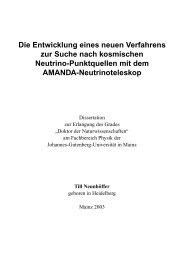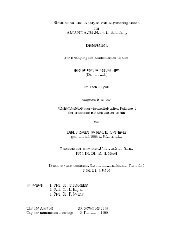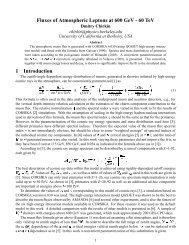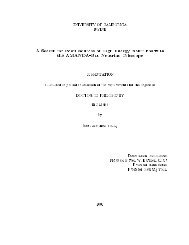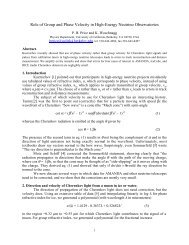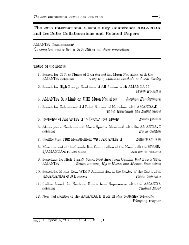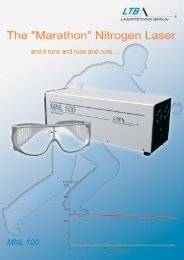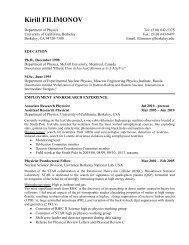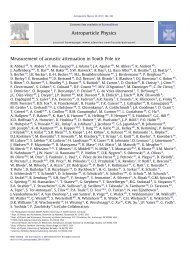Link to Fulltext
Link to Fulltext
Link to Fulltext
Create successful ePaper yourself
Turn your PDF publications into a flip-book with our unique Google optimized e-Paper software.
¡ ¢¡ £ <br />
At yet higher energies (greater than GeV for and greater than GeV for [9, 10,<br />
¡<br />
11]) atmospheric neutrinos are produced mainly as prompt decay products of charmed particles<br />
with very short life times.<br />
For primaries in the lower part of the cosmic ray energy spectrum, yielding lep<strong>to</strong>ns of a few<br />
GeV at most, a ratio value of 1/2 is expected for . However, this is not reflected in measurements<br />
made by some experiments – the so-called ’atmospheric anomaly’ [7]. Measurements<br />
made by IMB [12], SOUDAN2 [13] and Kamiokande [14] yielded a value closer <strong>to</strong> 1, whereas<br />
NUSEX [15] and Frejus [16] get results more in agreement with the predicted ratio of 1/2 [10].<br />
¢ <br />
When is greater than several GeV and production from muon decay can be neglected,<br />
the muon neutrino spectrum via pion and kaon decay is approximately given by [7]:<br />
¥¤ £<br />
¢ ¤§¦ £<br />
¨¢©¤<br />
<br />
<br />
£¤ <br />
¤ ¢ ¤ <br />
¡<br />
¡ ¡<br />
<br />
4<br />
£¤<br />
¤ ¢ ¤ (4)<br />
¡<br />
£ ¤ ¡ <br />
, ¤<br />
¦ ¡ where and is a constant that depends<br />
on the spectral index and on nucleon and pion attenuation lengths. The first term inside the<br />
¦<br />
parentheses represents neutrinos from the decay of pions. At energies ¢ ¤ , all the<br />
¢<br />
pions<br />
©<br />
,<br />
decay and the neutrino spectrum from pions follows the primary cosmic ray spectrum<br />
whereas at higher energies, pions can interact before decaying and the spectrum steepens <strong>to</strong><br />
© ¢ <br />
. For cascade development in the<br />
<br />
Earth’s<br />
<br />
atmosphere .<br />
¡<br />
Similar considerations apply for kaons, but since , kaon induced neutrinos<br />
will dominate over pion induced ones at high energies. Further terms can be added <strong>to</strong> Eq. 4 for<br />
charmed particles (see [10]) which, due <strong>to</strong> their high critical energy, will dominate for ¢ ¤ greater<br />
than 100 TeV.<br />
Since the contribution from muon decay <strong>to</strong> the production of atmospheric electron-<br />
(anti)neutrinos is inhibited by muon interaction, they have an energy spectrum steeper by one<br />
power (with a maximum around 30-40 MeV).<br />
The declination distribution of neutrinos is given by Eq. 4, i.e. is <br />
fundamentally<br />
¡ <br />
. For<br />
low energies however, the flux is strongly suppressed <strong>to</strong>wards the horizon, since the slant depth<br />
then becomes large and interactions of parent particles are more likely [11].<br />
As for cosmic neutrinos, they can be produced with the spectral index of the source if produced<br />
there, or with that of the diffusive cosmic ray spectrum if produced by particle collision<br />
with ISM (interstellar matter). They will retain their original spectrum in both cases, if we suppose<br />
that the matter densities they travel through are low.<br />
Atmospheric neutrinos have an energy distribution suppressed at energies high enough for<br />
their parent particles <strong>to</strong> interact with the atmosphere. Thus, sources of cosmic neutrinos should<br />
be detectable above the atmospheric background, given that their flux is large enough.<br />
Cosmic rays interacting with ISM will produce a flux of neutrinos which can be estimated<br />
<strong>to</strong> be ¢¡ © of the cosmic-ray flux in the PeV range [10]. It would be a diffuse flux, but originating<br />
mainly from regions with higher matter densities such as the spiral arms of our galaxy and<br />
molecular clouds and thus concentrated <strong>to</strong> the galactic plane (yielding some 5 events/year above<br />
10 TeV in a ¡ detec<strong>to</strong>r, well below the atmospheric<br />
<br />
neutrino<br />
<br />
background<br />
<br />
[10]). Another<br />
source is the Sun ¥<br />
which has a critical energy TeV, i.e. much higher than in the Earth’s atmosphere,<br />
and is more efficient at neutrino production. However, due <strong>to</strong> the limited<br />
<br />
angular<br />
<br />
size<br />
¢¡<br />
of the Sun, the predicted rates are very low (less than 2 events/year above 10 GeV in a<br />
detec<strong>to</strong>r [10]).



